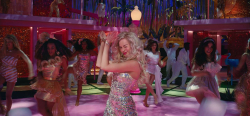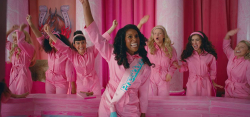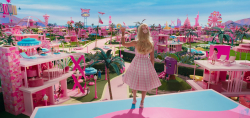Exploring Feminism Through the Lens of an Icon: The Barbie Movie Experience
The Barbie movie opens with a scene set in a sepia-toned desert where young girls are seen playing listlessly with traditional baby dolls. That is until the presence of Barbie, in her iconic swimsuit ignites excitement and enthusiasm among the children. This dramatic entrance sets the stage for the film, teasing the idea that Barbie has been not just a toy but a significant figure capable of inspiring and challenging gender norms, at least within the confines of her own realm, Barbieland.
In this utopian world, Barbie and her counterparts lead lives that epitomize perfection. They embody successful professionals ranging from doctors to presidents, boasting an array of accomplishments. Each day in Barbieland starts and ends ideally with a routine of flawless waffle breakfasts and jubilant dance parties. It's a place where female excellence is celebrated unreservedly, with no obstruction from societal impediments or biases. Men, represented by the Ken dolls, take on a far more passive role, spending their time leisurely at the beach.
The illusion of perfection begins to show cracks when the film's protagonist, Barbie, played by Robbie, dares to question the transient nature of existence during a meticulously staged dance routine. Her perfect life starts to lose its luster; her sleep becomes troubled, the waffles get burned, and her perfectly sculpted feet fail to support her. Seeking wisdom from Weird Barbie, portrayed by Kate McKinnon, Barbie learns that her role goes beyond Barbieland—it's her mission to aid a girl in the real world who is grappling with personal challenges.
As the film progresses, Barbie confronts the harsh realities of the real world—a place marred by gender discrimination and stereotyping. From derogatory catcalls to patronizing corporate executives, Barbie encounters the all-too-familiar societal obstacles faced by women daily. The movie boldly embraces discussions on gender relations, using wit and straightforward conversation to introduce themes typically found at the core of feminist debates.
Despite this, the movie portrays Barbieland as a place of diversity and inclusion, with a kaleidoscope of Barbies who span different races, abilities, and body types, including a Doctor Barbie brought to life by trans actor/model Hari Nef. This serves as an aspirational fantasy where myriad identities thrive harmoniously in an environment free from oppression.
However, the journey to the real world and the ensuing confrontations with sexism serve as more than just a plot device. They encourage introspection regarding the dual nature of Barbie's legacy: while she may signify unrealistic beauty standards and consumerism, she also represents the boundless potential within every woman.
The narrative acknowledges this dichotomy not just through its storytelling but by challenging the very core of its existence—the notion of deriving identity from possessions. This is particularly poignant for a film based on a product line, which could easily succumb to blatant consumerism. Instead, the movie consciously highlights the problematic aspects of materialism, as evidenced by a politically aware young character who eloquently criticizes the underlying issues associated with Barbie.
In a bold move for a film inspired by a toy franchise, the narrative questions the incessant pursuit of material goods. The story culminates in a compelling message that suggests true identity transcends mere belongings, a surprisingly subversive take on a film that could have been a straightforward promotional vehicle.
By weaving together themes of empowerment, inclusivity, and self-critique, the Barbie movie delivers an entertaining yet thought-provoking experience that invites viewers to reevaluate the cultural impact of a global toy phenomenon. It's a smart, spirited introduction to feminism wrapped in a glossy package, sparking a conversation about the complexity of the iconic doll's role in shaping societal expectations and personal identity.
Margot Robbie and Ryan Gosling Shine in "Barbie": A Blend of Vintage Charm and Witty Satire
In her public conversations about the film, director Greta Gerwig has often cited the influence of iconic movie musicals, a homage that is beautifully evident in the idyllic scenes of Barbieland. The rich, hand-painted landscapes, witty nods to cinema like the 2001 parody, the enchanting pink brick road, and the razzle-dazzle of a dance sequence reminiscent of Gene Kelly's iconic moment in "An American in Paris" provide a feast for movie buffs. Yet, despite these classical underpinnings, "Barbie" carries a distinctly contemporary beat, pulsating with satirical humor.
The film's comedic sensibilities align with modern satires that poke fun at the consumerist underbelly of popular culture, such as Deborah Kaplan and Harry Elfont's cult hit "Josie and the Pussycats" and Josh Greenbaum's side-splitting "Barb and Star Go to Vista Del Mar." In these films, as with "Barbie," satire is not only deployed for laughs but as a lens to critically examine cultural phenomena.
The masterful fusion of time-honored glamor with cutting-edge comedy could only be accomplished through the particular talents of Margot Robbie and Ryan Gosling. They not only encapsulate the essence of their roles but also capture the delicate balance that Gerwig seeks to strike between homage and humor. Robbie is a natural fit for the character, embodying Barbie's legendary aesthetics in both the movie and during public appearances. Nevertheless, Robbie brings depth to a character that could easily be misconstrued as superficial. Her portrayal of Barbie is not confined to the cheerful exterior projected in trailers. Instead, Robbie artfully navigates the inner turmoil of her character as Barbie grapples with societal expectations of perpetual joy amidst an onslaught of self-doubt and anxious thoughts, delivering a performance that is both heartfelt and nuanced.
Robbie and Gosling's performances are instrumental to the film's success; without their keen understanding of the blend of conventional and modern comedic tones, the movie might not have resonated as powerfully with audiences. With Robbie's dynamic portrayal of glamour and vulnerability and Gosling's flourishing charm, the pair elevates "Barbie" beyond its plastic origins to a cinematic work teeming with intelligence, wit, and a dash of Hollywood magic.
Conclusion
The Barbie movie emerges as an innovative and thought-provoking cultural piece, far surpassing expectations for a film inspired by a toy. Whether as a mirror to society or a beacon of aspiration, Barbie ultimately challenges us to envision a world where everyone is empowered to be the protagonist of their own story, facing the music with grace, humor, and an unwavering sense of identity. With its clever blend of levity and cultural critique, the movie marks an impactful addition to cinematic explorations of femininity and self-expression, leaving audiences with both a sense of nostalgia and a fresh perspective on an iconic brand.










